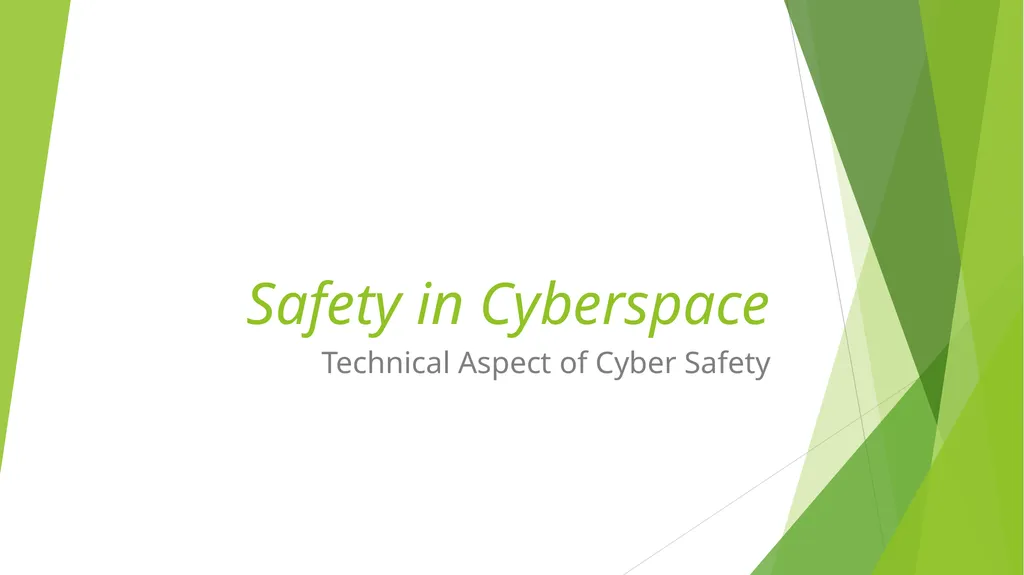Safety in Cyberspace Technical Aspect of Cyber
Author : trish-goza | Published Date : 2025-05-16
Description: Safety in Cyberspace Technical Aspect of Cyber Safety What is a cyberspace In simpler terms Cyberspace is the online world where digital activities happen over a network Cyberspace refers to the virtual environment created by
Presentation Embed Code
Download Presentation
Download
Presentation The PPT/PDF document
"Safety in Cyberspace Technical Aspect of Cyber" is the property of its rightful owner.
Permission is granted to download and print the materials on this website for personal, non-commercial use only,
and to display it on your personal computer provided you do not modify the materials and that you retain all
copyright notices contained in the materials. By downloading content from our website, you accept the terms of
this agreement.
Transcript:Safety in Cyberspace Technical Aspect of Cyber:
Safety in Cyberspace Technical Aspect of Cyber Safety What is a cyberspace? In simpler terms: Cyberspace is the "online world" where digital activities happen over a network. Cyberspace refers to the virtual environment created by interconnected digital networks where information is stored, shared, and communicated. It includes: The internet (websites, emails, social media) Computer systems and networks (both public and private) All digital communications (like messaging apps, cloud storage, etc.) What do we do in cyberspace? Communication : Sending emails, Messaging, Video calls and online meetings Social Interaction Using social media, Sharing photos, videos, and updates, Participating in forums and chat groups Information Access: Browsing websites, Reading news and blogs, Researching using search engines Online Transactions : Internet banking, Shopping on e-commerce platforms, Paying bills and booking tickets Entertainment : Streaming videos (YouTube, Netflix), Listening to music, Playing online games Work and Learning : Remote working, Online classes, e-learning platforms, Accessing cloud-based tools like Google Drive Data Sharing and Storage: Uploading and downloading files, Using cloud storage Cybersecurity Activities: Protecting data with antivirus and firewalls, Using passwords and encryption, Monitoring systems for threats Threats in Cyberspace Cybersecurity Threats : Hacking, Malware, Phishing Privacy Risks: Data breaches, Tracking and surveillance Financial Risks: Online fraud, Identity theft, Scams like fake schemes, investment fraud, or lottery scams online. Psychological and Social Risks: Cyberbullying, Addiction, Misinformation Technical Risks: System crashes or data loss due to poorly protected systems, Software vulnerabilities that can be exploited by attackers, Unpatched devices left open to attack. Phishing Attacks Description: Deceptive emails, messages, or websites that trick users into providing sensitive information (e.g., login credentials, credit card numbers). Variants: Spear phishing, whaling, vishing, smishing. Malware Description: Malicious software designed to damage, disrupt, or gain unauthorized access to systems. Examples: Viruses, worms, trojans, ransomware, spyware, adware. Ransomware Description: A type of malware that encrypts files and demands payment for the decryption key. Impact: Loss of access to critical data; often targets hospitals, schools, and businesses. Denial-of-Service (DoS) Attacks Description: Overloading a system, server, or network with traffic to render it unavailable to users. Targets: Websites, online services, infrastructure. Password Attacks Description: Attempts to obtain or guess passwords. Techniques: Brute force, dictionary attacks, credential stuffing, keylogging. Insider Threats Description: Security risks originating from within the organization—employees, contractors, or partners. Types: Malicious insiders, negligent insiders. How to know if our security is compromised? Unusual Device Activity Device getting heated-up Slow Performance Account














